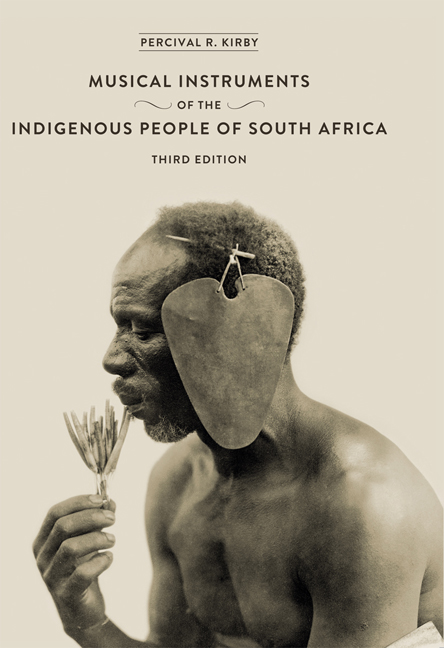Book contents
- Frontmatter
- Dedication
- Map
- Contents
- Foreword
- Preface to First Edition
- Preface to Second Edition
- Acknowledgements
- Acknowledgements to Third Edition
- List of Illustrations
- 1 Rattles and Clappers
- 2 Drums
- 3 Xylophones and ‘Sansas’
- 4 Bull-Roarers and Spinning-Disks
- 5 Horns and Trumpets
- 6 Whistles, Flutes, and Vibrating Reeds
- 7 Reed-Flute Ensembles
- 8 The ‘Gora’, A Stringed-Wind Instrument
- 9 Stringed Instruments
- 10 Bushman and Hottentot Violins and The ‘Ramkie’
- 11 Some European Instruments Played By Natives
- Appendix
- Addenda
- Index
10 - Bushman and Hottentot Violins and The ‘Ramkie’
Published online by Cambridge University Press: 21 April 2018
- Frontmatter
- Dedication
- Map
- Contents
- Foreword
- Preface to First Edition
- Preface to Second Edition
- Acknowledgements
- Acknowledgements to Third Edition
- List of Illustrations
- 1 Rattles and Clappers
- 2 Drums
- 3 Xylophones and ‘Sansas’
- 4 Bull-Roarers and Spinning-Disks
- 5 Horns and Trumpets
- 6 Whistles, Flutes, and Vibrating Reeds
- 7 Reed-Flute Ensembles
- 8 The ‘Gora’, A Stringed-Wind Instrument
- 9 Stringed Instruments
- 10 Bushman and Hottentot Violins and The ‘Ramkie’
- 11 Some European Instruments Played By Natives
- Appendix
- Addenda
- Index
Summary
THE native peoples of South Africa share, with other simple races, the tendency to imitate European articles which take their fancy, using for their construction such local materials as may be suitable or available. This tendency has already been referred to in connexion with several varieties of musical instruments such as drums and whistles, and it is particularly interesting to observe how the fashioning of and performance upon indigenous instruments has remained practically uninfluenced by such imitations, which, untrammelled by taboos or ceremonial restrictions, seem to have always stood apart.
One type of these merits some consideration in a study of Native musical instruments, the imitation of the European violin. Undoubtedly at a very early date the violin was brought to South Africa, and was heard and marvelled at by the aborigines. It is hardly necessary to quote a long list of references to the employment of the instrument by European residents in the country; it will suffice to say that its use was widespread, though naturally it was in the more important settlements that the natives first met with it.
The Bushmen and the Hottentots appear to have been struck by the musical possibilities of the violin, and, since they were usually unable to purchase one, frequently attempted to construct specimens for themselves. A number of references to this practice occur throughout the writings of travellers and others.
Sparrman (1772-6) described a rudimentary attempt of this nature made by the Cape Hottentots. ‘T'Guthe is the name of another instrument, which, probably, was first made in imitation of a violin. It consists merely of a piece of board with three or four strings screwed on to it, on which they scrape with a bow.’ He adds, ‘I much doubt, whether the Boshies-men have either t'guthes or t'goerras [the gora] among them.’
Burchell (1811) gave details of the construction of a rather better instrument made by his Hottentot servant, Speelman, whose name is significant.
- Type
- Chapter
- Information
- The Musical Instruments of the Indigenous People of South Africa , pp. 332 - 348Publisher: Wits University PressPrint publication year: 2013



